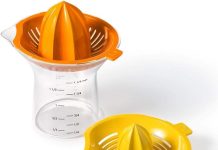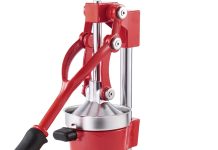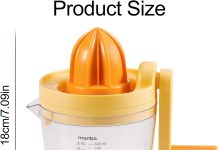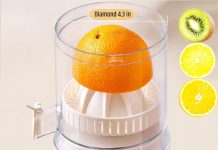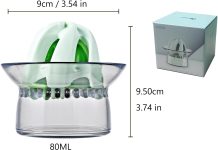Let’s talk about something important – the safety precautions you need to keep in mind while using a juicer. We all love a fresh glass of juice, but it’s always wise to take some precautions to ensure our juicing experience is both enjoyable and safe. In this article, we’ll discuss the potential hazards that may arise when using a juicer and share some easy steps to keep ourselves out of harm’s way. So, grab a seat, and let’s dive into the world of juicing safety!
Review contents
Importance of Safety Precautions
Avoiding Accidents
When using a juicer, it is crucial to prioritize safety precautions. By doing so, we can avoid accidents that can cause harm to ourselves or others. Accidents can occur due to various factors, such as the misuse of equipment or negligence in following safety guidelines. By being mindful and taking necessary precautions, we can greatly reduce the likelihood of accidents while using a juicer.
Preventing Injuries
One of the key reasons why safety precautions are of utmost importance is to prevent injuries. Juicers operate using sharp blades and powerful motors, making them potentially hazardous if not handled with care. Injuries can range from minor cuts and scrapes to more severe lacerations or even amputations. By following proper safety procedures and using the juicer correctly, we can significantly decrease the risk of injuries.
Maintaining Appliance Durability
Another aspect to consider when discussing the importance of safety precautions is the longevity of the juicer. By following the recommended safety guidelines, we can ensure that the appliance remains in good working condition for an extended period. Proper usage and maintenance will not only prevent accidents and injuries but also contribute to the durability of the juicer. This allows us to enjoy the benefits of juicing for a longer time while minimizing the need for repairs or replacement.
Choosing a Safe Juicer
This image is property of juicernet.com.
Look for Safety Certifications
When selecting a juicer, it is essential to look for safety certifications. These certifications indicate that the juicer has undergone rigorous testing to meet specific safety standards. Look for certifications from recognized organizations such as Underwriters Laboratories (UL) or the Canadian Standards Association (CSA). These certifications ensure that the juicer has undergone thorough evaluations for electrical safety, performance, and overall quality.
Consider Design Features
The design of a juicer can play a significant role in its safety. Look for features such as lockable lids or safety switches that prevent the juicer from operating if the components are not correctly assembled. This helps to minimize the risk of accidents while using the appliance. Additionally, consider juicers with wide feeding chutes, as they can reduce the need for cutting produce into smaller pieces, which can be a potential source of injuries.
Read Customer Reviews
Customer reviews can provide valuable insights into the safety of a juicer. Look for reviews that specifically mention the juicer’s safety features, ease of use, and any potential hazards. Pay attention to any recurring complaints or safety concerns raised by previous users. By opting for a juicer with positive safety feedback, we can have peace of mind knowing that we have chosen a safer option for our juicing needs.
Preparing the Juicer
Cleaning the Juicer
Before using the juicer, it is essential to clean it thoroughly. Most juicers come with specific cleaning instructions, which should be followed meticulously. Cleaning the juicer prevents the buildup of bacteria or mold on its components, ensuring the safety and cleanliness of the juice produced. It is advisable to clean the juicer immediately after each use, using warm water and mild detergent to remove any residue.
This image is property of www.juicer-sunshine.com.
Inspecting the Parts
Inspecting the juicer’s parts is crucial to ensure they are in good condition. Regularly check for any signs of wear and tear, cracks, or damage to the blades, filters, or other components. Using a damaged juicer can be dangerous and affect the quality of the juice. If any parts are found to be faulty or compromised, they should be replaced immediately with genuine parts to maintain the juicer’s safety and performance.
Choosing the Right Surface
When operating the juicer, it is important to choose a stable and suitable surface. Place the juicer on a flat and sturdy countertop, away from the edge. Ensure that the surface is clean and dry to prevent slippage during operation. Avoid placing the juicer on a surface that is prone to vibrations or movement, as this can lead to accidents or spills. Selecting an appropriate surface for juicing contributes to a safe and hassle-free juicing experience.
Operating the Juicer Safely
Following the Manufacturer’s Instructions
To ensure safe operation, it is crucial to carefully read and follow the manufacturer’s instructions provided with the juicer. The instructions provide essential information on how to assemble, operate, and maintain the juicer properly. Pay close attention to any warnings, cautions, or specific procedures outlined by the manufacturer. Failure to follow these instructions can compromise both the safety of the user and the performance of the juicer.
Using Pusher Safely
Some juicers come with a pusher tool designed to help feed produce into the juicer. It is important to use the pusher tool correctly and safely. Always ensure that your hands and fingers are kept away from the feeding chute while using the pusher. Do not apply excessive force or push too many pieces of produce at once, as this can strain the motor and risk injury. Using the pusher as instructed will help maintain a safe juicing environment.
This image is property of cdn.mos.cms.futurecdn.net.
Avoiding Overloading the Juicer
Overloading the juicer can pose safety risks and affect its performance. Follow the juicer’s capacity guidelines to determine the maximum amount of produce it can process at once. Overloading the juicer can cause strain on the motor, potentially leading to overheating or malfunction. Additionally, it can cause an imbalance of the juicer, making it unstable during operation. By adhering to the recommended load limits, we can avoid potential accidents and maintain optimal juicer performance.
Handling Produce Properly
Washing Fruits and Vegetables
Before juicing, it is crucial to wash fruits and vegetables thoroughly. This helps remove dirt, pesticides, and other contaminants that may be present on the produce’s surface. Washing produce under running water and using a brush when necessary can significantly reduce the risk of consuming harmful substances. Clean produce contributes to a safer and healthier juicing experience.
Removing Inedible Parts
Properly preparing produce for juicing involves removing any inedible parts or potentially hazardous elements. This includes removing pits, seeds, or tough skins that may not be suitable for juicing. Inedible parts can damage the juicer’s blades or clog the filters, leading to operational issues and safety concerns. By carefully inspecting and removing any inedible parts, we can ensure smoother juicing and minimize potential risks.
Storing Produce Correctly
Storing produce in the appropriate conditions is essential to maintain its freshness and safety. Keep fruits and vegetables in a clean and dry area, away from potential contaminants. Store them at the recommended temperatures to prevent spoilage or the growth of harmful bacteria. Properly storing produce not only contributes to the quality of the juice but also avoids potential health risks associated with consuming spoiled or contaminated ingredients.
This image is property of hips.hearstapps.com.
Avoiding Cross-Contamination
Clean Cutting Boards and Knives
To prevent cross-contamination, it is crucial to clean cutting boards and knives thoroughly after each use. Raw fruits and vegetables can carry bacteria or other microorganisms, which can transfer to other foods through contact. Use hot, soapy water to clean cutting boards and knives or run them through the dishwasher if they are dishwasher-safe. This helps eliminate any potential pathogens and minimizes the risk of foodborne illnesses.
Follow Proper Food Handling Practices
Adhering to proper food handling practices is essential to avoid cross-contamination. Wash hands thoroughly before and after handling any food, including produce for juicing. Use separate utensils and cutting boards for different ingredients, especially when dealing with raw meat, poultry, or seafood. By establishing good food handling habits, we can maintain a safe and hygienic juicing environment.
Use Separate Containers for Different Ingredients
When juicing multiple ingredients, it is advisable to use separate containers for each ingredient. This prevents the mixing of different flavors and reduces the risk of potential reactions between ingredients. Additionally, using separate containers minimizes the risk of cross-contamination between ingredients and ensures that each juice maintains its distinct flavor and nutritional value. Practicing proper ingredient segregation promotes a safer and more enjoyable juicing experience.
Maintaining Personal Hygiene
This image is property of cdn.thewirecutter.com.
Washing Hands Before and After Juicing
Clean hands are essential for maintaining personal hygiene while handling food and using a juicer. Wash hands thoroughly with soap and warm water before and after juicing. This helps eliminate potential bacteria or contaminants present on the hands that could transfer to the produce or juice. Proper handwashing is a simple yet effective practice that plays a significant role in preventing foodborne illnesses and maintaining a safe juicing environment.
Avoiding Contact with Open Cuts or Wounds
When using a juicer, it is crucial to avoid contact between open cuts or wounds and the produce or juicer components. Open cuts or wounds can serve as entry points for bacteria or other contaminants, increasing the risk of infection. Use gloves or cover any open cuts or wounds to prevent direct contact with the juicer or ingredients. This precaution helps safeguard against potential infections and maintains the overall safety of the juicing process.
Tying Back Long Hair
For those with long hair, it is important to tie it back when using a juicer. Loose hair can easily become entangled in the juicer’s moving parts, posing a safety risk. By tying back long hair or wearing a hairnet, we can prevent accidents and ensure that hair does not interfere with the juicer’s operation. This simple measure helps maintain personal safety and hygiene while juicing.
Dealing with Electrical Safety
Plugging in the Juicer Safely
When using an electrical appliance like a juicer, it is vital to plug it in safely. Ensure that the power cord is in good condition without any frays or exposed wires. Plug the juicer into a grounded outlet that matches its voltage requirements. Avoid using extension cords or overloading the power supply. Properly plugging in the juicer minimizes the risk of electrical hazards and ensures safe operation.
Avoiding Wet Surfaces
Water and electricity are a dangerous combination, so it is crucial to avoid using the juicer on wet surfaces. Ensure that the countertop or area where the juicer will be used is dry before beginning operation. Accidental spills or splashes can occur during juicing, and a wet surface can increase the risk of electrical shock. Keeping the juicer away from wet areas significantly reduces the likelihood of electrical accidents.
Using a Ground Fault Circuit Interrupter (GFCI)
Consider using a Ground Fault Circuit Interrupter (GFCI) when operating electrical appliances like juicers. A GFCI is a safety device that helps protect against electrical shocks by detecting any imbalances in the electrical circuit. It quickly shuts off power if it senses a fault, preventing potential injuries. Installing a GFCI can provide an extra layer of protection and ensure electrical safety while using a juicer.
Cleaning and Maintenance
Unplugging the Juicer Before Cleaning
Before cleaning the juicer, always remember to unplug it from the power source. This step is essential to prevent any accidental activation of the juicer during the cleaning process. Unplugging the juicer minimizes the risk of injuries and electrical hazards while handling and cleaning the individual components.
Disassembling and Cleaning Each Part
When cleaning the juicer, it is crucial to disassemble and clean each part thoroughly. Refer to the manufacturer’s instructions for detailed disassembly guidelines. Use warm water, mild detergent, and a soft brush or sponge to clean all the components. Pay close attention to the blades, filters, and any crevices where residue might accumulate. Proper cleaning helps ensure that the juicer remains hygienic, safe to use, and free from potential contaminants.
Drying and Storing the Juicer Properly
After cleaning the juicer, it is important to dry each component thoroughly. Leaving water or moisture on the parts can lead to mold or bacterial growth. Towel-dry the components or leave them to air-dry completely before reassembling or storing them. Once dry, store the juicer in a clean and dry area, preferably in a well-ventilated space. Proper drying and storage contribute to the longevity and safety of the juicer.
Ensuring Child Safety
Keeping Juicers out of Reach
When it comes to juicer safety, it is crucial to keep the appliance out of the reach of children. Juicers contain sharp blades and motorized components that can cause severe injuries to little ones. Store the juicer in a high cabinet or locked cupboard where children cannot access it. By keeping juicers out of reach, we can effectively prevent accidents and protect our children from any harm.
Supervising Children’s Use
If children are allowed to use the juicer, it is essential to supervise them closely. Ensure that they follow the manufacturer’s instructions and receive proper guidance on safe juicing practices. Teach them how to handle produce and operate the juicer cautiously. By supervising their use, we can mitigate potential risks and instill responsible juicing habits from an early age.
Educating Children on Juicer Safety
Education plays a vital role in ensuring child safety when using a juicer. Take the time to educate children about the potential hazards associated with juicers and the importance of following safety precautions. Teach them about proper handwashing, handling produce, and avoiding contact with the juicer’s moving parts. By imparting this knowledge, we empower our children to make informed decisions and prioritize safety when using a juicer.
In conclusion, safety precautions are of utmost importance when using a juicer. By following these precautions, we can avoid accidents, prevent injuries, and maintain the durability of our appliances. From choosing a safe juicer to handling produce properly and maintaining personal hygiene, each step contributes to a safer and more enjoyable juicing experience. Remember, prioritizing safety ensures that we can reap the many benefits of juicing while minimizing the risks involved. Happy and safe juicing!








